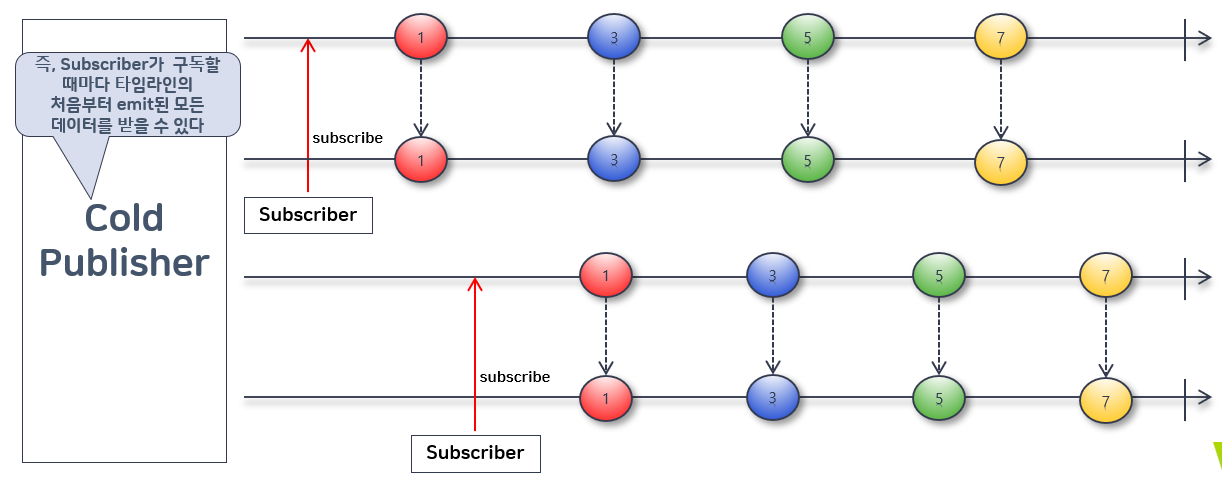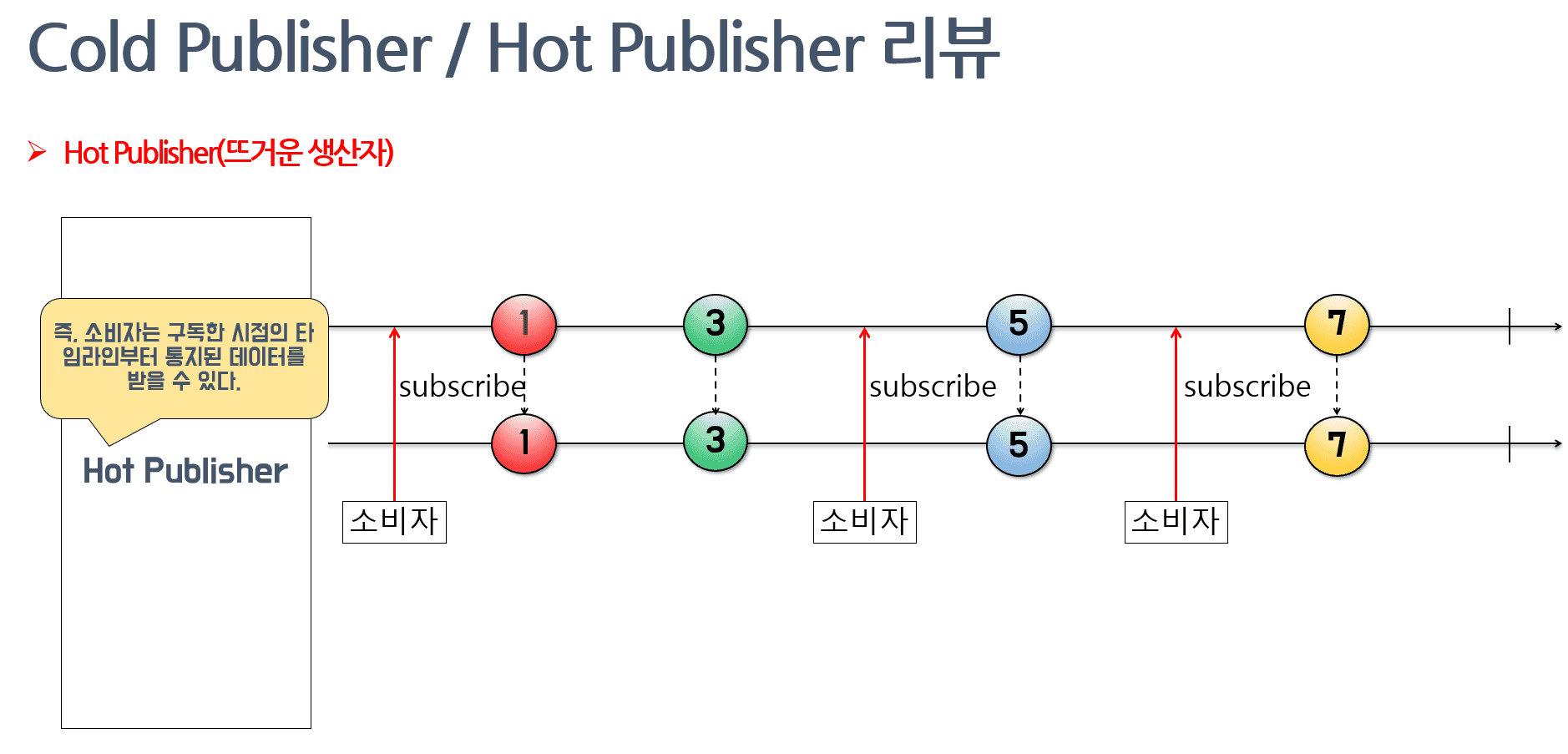
Cold와 Hot의 의미
Cold는 무언가를 새로 시작하고, Hot은 무언가를 새로 시작하지 않는다.
- Hot Swap
- 컴퓨터 시스템의 전원이 켜져 있는 상태에서 디스크 등의 장치를 교체할 경우 시스템을 재시작하지 않고서도 바로 장치를 인식하는 것
- Hot Deploy
- 서버를 재시작하지 않고서 응용 프로그램의 변경 사항을 적용할 수 있는 기능
- Hot Wallet
- 인터넷에 연결되어 있기 때문에, 즉시 사용이 가능하지만 보안에 취약
- Cold Wallet
- 인터넷과 단절되어 있어서 사용성은 떨어지지만 보안이 강화된다는 특성
Cold Sequence
Subscriber가 구독할 때 마다 데이터 흐름이 처음부터 다시 시작되는 Sequence

Flux<String> coldFlux =
Flux
.fromIterable(Arrays.asList("KOREA", "JAPAN", "CHINESE"))
.map(String::toLowerCase);
coldFlux.subscribe(country -> log.info("# Subscriber1: {}", country));
System.out.println("----------------------------------------------------------------------");
Thread.sleep(2000L);
coldFlux.subscribe(country -> log.info("# Subscriber2: {}", country));
// 01:27:07.332 [main] DEBUG- Using Slf4j logging framework
// 01:27:07.340 [main] INFO - # Subscriber1: korea
// 01:27:07.340 [main] INFO - # Subscriber1: japan
// 01:27:07.340 [main] INFO - # Subscriber1: chinese
// ----------------------------------------------------------------------
// 01:27:09.347 [main] INFO - # Subscriber2: korea
// 01:27:09.348 [main] INFO - # Subscriber2: japan
// 01:27:09.352 [main] INFO - # Subscriber2: chineseHot Seqeunce
구독이 발생한 시점 이전에 Publisher로부터 emit 된 데이터는 Subscriber가 전달받지 못한다.
구독이 발생한 시점 이후에 emit된 데이터만 전달받을 수 있다.

String[] singers = {"Singer A", "Singer B", "Singer C", "Singer D", "Singer E"};
log.info("# Begin concert:");
Flux<String> concertFlux =
Flux
.fromArray(singers)
.delayElements(Duration.ofSeconds(1))
.share();
concertFlux.subscribe(
singer -> log.info("# Subscriber1 is watching {}'s song", singer)
);
Thread.sleep(2500);
concertFlux.subscribe(
singer -> log.info("# Subscriber2 is watching {}'s song", singer)
);
Thread.sleep(3000);
// 01:31:24.967 [main] INFO - # Begin concert:
// 01:31:25.018 [main] DEBUG- Using Slf4j logging framework
// 01:31:26.064 [parallel-1] INFO - # Subscriber1 is watching Singer A's song
// 01:31:27.070 [parallel-2] INFO - # Subscriber1 is watching Singer B's song
// 01:31:28.080 [parallel-3] INFO - # Subscriber1 is watching Singer C's song
// 01:31:28.081 [parallel-3] INFO - # Subscriber2 is watching Singer C's song
// 01:31:29.087 [parallel-4] INFO - # Subscriber1 is watching Singer D's song
// 01:31:29.091 [parallel-4] INFO - # Subscriber2 is watching Singer D's song
// 01:31:30.101 [parallel-5] INFO - # Subscriber1 is watching Singer E's song
// 01:31:30.101 [parallel-5] INFO - # Subscriber2 is watching Singer E's songdelayElements()- 데이터 소스로 입력된 각 데이터의 emit을 일정시간 동안 지연시키는 Operator
share()- Cold Sequence를 Hot Sequence로 동작하게 해주는 Operator
- 여러 Subscriber가 하나의 원본 Flux를 공유한다.
cache() Operator
- Cold Sequence로 동작하는 Publisher를 Hot Sequence로 변경해준다.
- emit된 데이터를 캐시한 뒤, 구독이 발생할 때 마다 캐시된 데이터를 전달한다.
public static void main(String[] args) throws InterruptedException {
URI worldTimeUri = UriComponentsBuilder.newInstance().scheme("http")
.host("worldtimeapi.org")
.port(80)
.path("/api/timezone/Asia/Seoul")
.build()
.encode()
.toUri();
Mono<String> mono = getWorldTime(worldTimeUri).cache();
mono.subscribe(dateTime -> log.info("# dateTime 1: {}", dateTime));
Thread.sleep(2000);
mono.subscribe(dateTime -> log.info("# dateTime 2: {}", dateTime));
Thread.sleep(2000);
}
private static Mono<String> getWorldTime(URI worldTimeUri) {
return WebClient.create()
.get()
.uri(worldTimeUri)
.retrieve()
.bodyToMono(String.class)
.map(response -> {
DocumentContext jsonContext = JsonPath.parse(response);
return jsonContext.read("$.datetime");
});
}정리
- Subscriber의 구독 시점이 달라도, 구독할 때마다 Publisher가 데이터를 처음부터 emit하는 과정을
Cold Sequence라고 한다. Cold Sequence흐름으로 동작하는 Publisher를Cold Publisher라고 한다.- Publisher가 데이터를 emit하는 과정이 한 번만 일어나고, Subscriber가 각각의 구독 시점 이후에 emit된 데이터만 전달받는 것을
Hot Sequence라고 한다. Hot Sequence흐름으로 동작하는 Publisher를Hot Publisher라고 한다.- share(), cache() 등의 Operator를 사용해서 Cold Sequence를 Hot Seqeunce로 변환할 수 있다.
